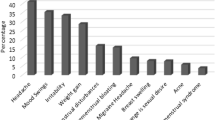Abstract
Background: Hormonal contraceptives (HCs) are the most common contraceptive method in western countries. The fears and problems experienced by users of HCs can have an impact on their quality of life, and lead to abortions and unwanted pregnancies.
Objective: To investigate whether experiences and perceptions of HC users in Finland have changed from 2001 to 2007.
Methods: Data were collected using questionnaire surveys of women using HCs in 2001 and 2007. In Finland, HCs are available with a physician’s prescription, and are only supplied in community and university pharmacies. University pharmacies in 12 large cities across Finland were selected to distribute the questionnaires. The response rate was 53% (n = 264) in 2001 and 55% (n = 436) in 2007. The average age of the respondents was 26 years in both surveys. The surveys measured self-reported benefits and adverse reactions, preconceptions, fears, knowledge, and opinions.
Results: The number of HC users reporting fears increased from 2001 to 2007 (p = 0.002), whereas the number of HC users reporting adverse reactions decreased (p = 0.013). In both surveys, the most common fear was infertility after HC use (17% vs 26% for 2001 and 2007, respectively). In both surveys, the most common benefits were efficacy and regular menstrual cycle, and the most common adverse reactions were mood swings, lowered libido, and weight gain.
Conclusions: Our study suggests that, although women using HCs were convinced about their benefits, and the number of users reporting adverse reactions had decreased from 2001 to 2007, the number of users reporting fears had increased. Healthcare professionals need to provide counseling in order to alleviate women’s fears and to correct false perceptions of HCs.





Similar content being viewed by others
Notes
The use of trade names is for product identification purposes only and does not imply endorsement.
References
United Nations Department of Economic and Social Affairs: Population Division. World contraceptive use 2005 [online]. Available from URL: http://www.un.org/esa/population/publications/contraceptive2005/WCU2005.htm [Accessed 2005 Feb 15]
Kosunen EA, Sihvo S, Nikula M, et al. Birth control. In: Koponen P, Luoto R, editors. Reproductive health in Finland: the Health 2000 survey. B/2004 ed. Helsinki: National Public Health Institute, 2004
Nomesco. Medicines consumption in the Nordic countries 1999–2003 [online]. Available from URL: http://nomescoeng.nom-nos.dk/default.asp?side=204 [Accessed 2005 Feb 15]
National Research and Development Centre for Welfare and Health (STAKES). Reproduction [online]. Available from URL: http://www.stakes.fi/EN/Tilastot/statisticsbytopic/reproduction/index.htm [Accessed 2005 Feb 15]
Jones RK, Darroch JE, Henshaw SK. Contraceptive use among US women having abortions in 2000–2001. Perspect Sex Reprod Health 2002; 34(6): 294–303
Rosenberg MJ, Waugh MS, Meehan TE. Use and misuse of oral contraceptives: risk indicators for poor pill taking and discontinuation. Contraception 1995; 51: 283–8
Westhoff CL, Heartwell S, Edwards S, et al. Oral contraceptive discontinuation: do side effects matter? Am J Obstet Gynecol 2007; 196: 412e1–e7
Tiihonen MJ, Heikkinen A-M, Ahonen RS. Do Finnish women using hormone replacement therapy need more information about risks. Pharm World Sci 2007; 29(6): 635–40
National Agency for Medicines and Social Insurance Institution. The Finnish statistics of medicine 2005. Helsinki: Edita Prima Oy, 2006
Sihvo S, Ahonen R, Mikander H, et al. Self-medication with vaginal antifungal drugs: physicians’ experiences and women’s utilization patterns. Fam Pract 2000 Apr; 17(2): 145–9
Data on file, Bayer AG, 2007
Farrow A, Hull MG, Northstone K, et al. Prolonged use of oral contraception before planned pregnancy is associated with a decreased risk of delayed conception. Hum Reprod 2002 Oct 17; 10: 2754–61
Murphy P, Kirkman A, Hale RW. A national survey of women’s attitudes toward oral contraception and other forms of birth control. Womens Health Issues 1995; 5(2): 94–9
Gilliam ML, Tapia B, Warden M, et al. Concerns about contraceptive side effects among young Latinas: a focus-group approach. Contraception 2004; 70(4): 299–305
Gallo MF, Grimes DA, Schulz KF, et al. Combination estrogenprogestin contraceptives and body weight: systematic review of randomized controlled trials. Obstet Gynecol 2004 Feb; 103(2): 359–73
Rosenberg MJ, Waugh MS, Burnhill MS. Compliance, counseling and satisfaction with oral contraceptives: a prospective evaluation. Fam Plann Perspect 1998 Mar–Apr; 30(2): 89–92
Oddens BJ. Women’s satisfaction with birth control: a population survey of physical and psychological effects of oral contraceptives, intrauterine devices, condoms, natural family planning, and sterilization among 1466 women. Contraception 1999 May; 59(5): 277–86
Sihvo S, Hemminki E. Self-medication of dyspepsia: how appropriate is it? Scand J Gastroenterol 1997 Sep; 32(9): 855–61
Vainio K. Developing patient counselling in Finnish community pharmacies. Kuopio: Kuopio University Publications A. Pharmaceutical Sciences 78, 2004
Acknowledgments
No sources of funding were used to assist in the preparation of this study. The authors have no conflicts of interest that are directly relevant to the content of this study.
Author information
Authors and Affiliations
Corresponding author
Rights and permissions
About this article
Cite this article
Tiihonen, M., Leppänen, HM., Heikkinen, AM. et al. Hormonal Contraceptive Users’ Self-Reported Benefits, Adverse Reactions, and Fears in 2001 and 2007. Patient-Patient-Centered-Outcome-Res 1, 173–180 (2008). https://doi.org/10.2165/1312067-200801030-00004
Published:
Issue Date:
DOI: https://doi.org/10.2165/1312067-200801030-00004



